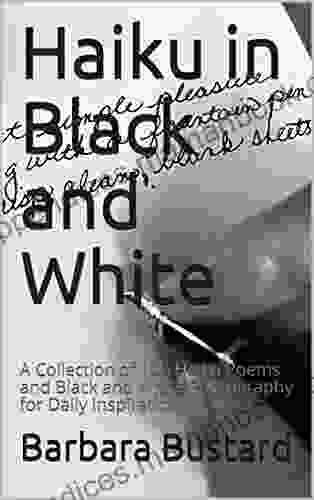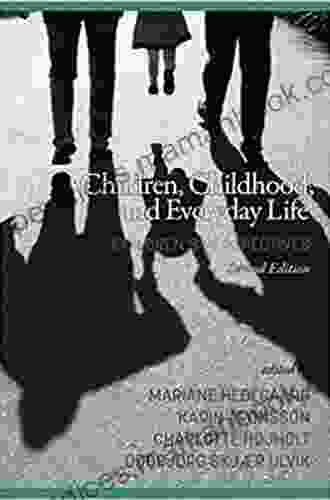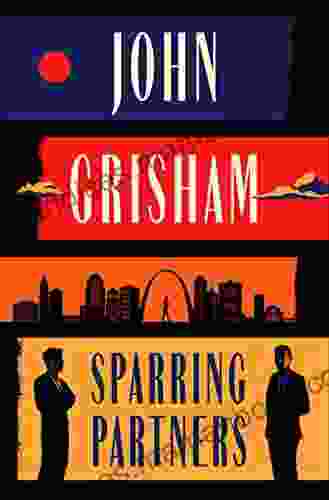Haiku in Black and White: Exploring the Timeless Beauty of Simplicity

Amidst the tapestry of literary arts, haiku stands out as a testament to the profound beauty that can be found in simplicity. With its concise structure and profound imagery, haiku in black and white captures the essence of life in a few fleeting yet poignant lines. Through a harmonious blend of observation and reflection, these verses offer glimpses into the intricate dance between transience and eternity, the cyclical nature of the natural world, and the often-overlooked beauty of the everyday.
Origins and Poetic Form
Haiku, a poetic form originating in 17th-century Japan, has captivated poets and readers alike for centuries. The traditional haiku consists of three unrhymed lines, with a syllable count of 5-7-5. This brevity forces poets to distill their thoughts and observations into a concise and evocative form, allowing for multiple layers of meaning to be conveyed within its limited structure.
4.7 out of 5
| Language | : | English |
| File size | : | 20779 KB |
| Screen Reader | : | Supported |
| Print length | : | 213 pages |
| Lending | : | Enabled |
| Paperback | : | 96 pages |
| Item Weight | : | 6.4 ounces |
| Dimensions | : | 5.25 x 0.75 x 8.25 inches |
Black and White: The Contrast of Existence
The use of black and white in haiku is not merely a matter of aesthetics; it represents a profound philosophical undercurrent that explores the duality of existence. The contrast between these two extremes highlights the ephemeral nature of life and the enduring power of the universe. Within the realm of black and white, haiku delve into themes of birth and death, joy and sorrow, light and darkness, inviting readers to contemplate the delicate balance that governs all things.
Nature's Cycles and Transience
Haiku in black and white often find inspiration in the natural world, observing the cyclical nature of life and the fleeting beauty of each moment. The changing seasons, the blossoming of flowers, the falling of leaves—all become subjects for contemplation. Through these observations, haiku remind us that all things must pass, urging us to cherish each present moment while acknowledging its impermanence.
Consider this haiku by Basho, one of the most renowned masters of the form:
Ancient pond
A frog jumps into the water
Splash! Silence again
This haiku captures the essence of transience through the simple act of a frog leaping into a pond. The splash, a momentary disruption, is followed by a return to silence, symbolizing the passing of time and the ephemeral nature of existence.
Everyday Beauty in the Ordinary
While haiku often explore grand themes of life and nature, they also find beauty in the seemingly mundane moments of everyday life. A cup of tea, a walk in the park, a conversation with a friend—these ordinary experiences become sources of insight and reflection in the hands of skilled haiku poets.
Take, for example, this haiku by Issa, another renowned haiku master:
A world of dew
And within every dewdrop
A world of struggle
Through the observation of morning dew, Issa reveals the hidden struggles and complexities that exist within even the smallest and most ordinary things. Haiku thus encourage us to slow down, to appreciate the beauty that surrounds us in every moment, no matter how insignificant it may seem.
The Power of Suggestion and Implication
One of the key characteristics of haiku in black and white is their use of suggestion and implication. Poets rely on carefully chosen imagery and juxtapositions to evoke emotions and ideas that extend beyond the literal meaning of the words. By leaving certain elements unsaid, haiku invite readers to engage in active interpretation, creating a shared experience between poet and reader.
In this haiku by Shiki, a prominent haiku poet of the late 19th century, the reader is left to ponder the implications of a seemingly simple scene:
A lonely crow
On a bare branch in autumn
Evening approaches
The isolation of the crow, perched on a barren branch as evening falls, evokes a sense of melancholy and loneliness. Shiki's haiku prompts us to reflect on our own feelings of isolation and the passing of time.
A Timeless Art Form
Haiku in black and white have endured for centuries, continuing to captivate readers with their timeless beauty and profound insights. They serve as a reminder that even in the face of life's complexities and fleeting nature, there is beauty and meaning to be found. Through the simplicity of their structure and the depth of their imagery, haiku invite us to slow down, to observe the world around us with fresh eyes, and to appreciate the interconnectedness of all things.
As we navigate the uncertainties of modern life, haiku offer a sanctuary of peace and reflection. They remind us to embrace the present moment, to find solace in the rhythms of nature, and to seek beauty in the seemingly ordinary. By immersing ourselves in the world of haiku in black and white, we cultivate a deeper understanding of ourselves, our place in the universe, and the enduring power of art.
4.7 out of 5
| Language | : | English |
| File size | : | 20779 KB |
| Screen Reader | : | Supported |
| Print length | : | 213 pages |
| Lending | : | Enabled |
| Paperback | : | 96 pages |
| Item Weight | : | 6.4 ounces |
| Dimensions | : | 5.25 x 0.75 x 8.25 inches |
Do you want to contribute by writing guest posts on this blog?
Please contact us and send us a resume of previous articles that you have written.
 Top Book
Top Book Novel
Novel Fiction
Fiction Nonfiction
Nonfiction Literature
Literature Paperback
Paperback Hardcover
Hardcover E-book
E-book Audiobook
Audiobook Bestseller
Bestseller Classic
Classic Mystery
Mystery Thriller
Thriller Romance
Romance Fantasy
Fantasy Science Fiction
Science Fiction Biography
Biography Memoir
Memoir Autobiography
Autobiography Poetry
Poetry Drama
Drama Historical Fiction
Historical Fiction Self-help
Self-help Young Adult
Young Adult Childrens Books
Childrens Books Graphic Novel
Graphic Novel Anthology
Anthology Series
Series Encyclopedia
Encyclopedia Reference
Reference Guidebook
Guidebook Textbook
Textbook Workbook
Workbook Journal
Journal Diary
Diary Manuscript
Manuscript Folio
Folio Pulp Fiction
Pulp Fiction Short Stories
Short Stories Fairy Tales
Fairy Tales Fables
Fables Mythology
Mythology Philosophy
Philosophy Religion
Religion Spirituality
Spirituality Essays
Essays Critique
Critique Commentary
Commentary Glossary
Glossary Bibliography
Bibliography Index
Index Table of Contents
Table of Contents Preface
Preface Introduction
Introduction Foreword
Foreword Afterword
Afterword Appendices
Appendices Annotations
Annotations Footnotes
Footnotes Epilogue
Epilogue Prologue
Prologue T R Croke
T R Croke Margo Maguire
Margo Maguire Mary P Richards
Mary P Richards David Benjamin
David Benjamin Daniel Kahneman
Daniel Kahneman George Szirtes
George Szirtes Gordon D W Curtis
Gordon D W Curtis Marv Aden
Marv Aden Amy Oestreicher
Amy Oestreicher Rich Parsons
Rich Parsons Carrie Newcomer
Carrie Newcomer Annabel Woolmer
Annabel Woolmer Kate Andersen Brower
Kate Andersen Brower Mark A Biggs
Mark A Biggs Katia Lief
Katia Lief Craig Buck
Craig Buck Lisa Gardner
Lisa Gardner Carl Phillips
Carl Phillips R E Mcdermott
R E Mcdermott Monore Monroe
Monore Monroe
Light bulbAdvertise smarter! Our strategic ad space ensures maximum exposure. Reserve your spot today!
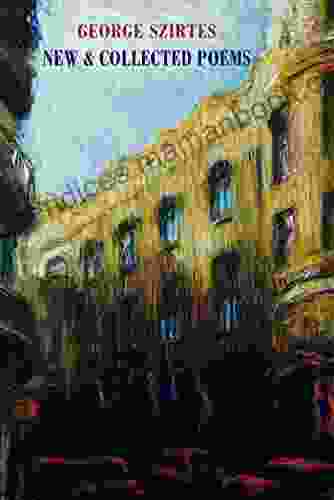
 Cormac McCarthyExploring the Profound and Enchanting World of Poetry with George Szirtes'...
Cormac McCarthyExploring the Profound and Enchanting World of Poetry with George Szirtes'... Jessie CoxFollow ·8.6k
Jessie CoxFollow ·8.6k Marc FosterFollow ·8.8k
Marc FosterFollow ·8.8k Manuel ButlerFollow ·9.3k
Manuel ButlerFollow ·9.3k George BellFollow ·10.9k
George BellFollow ·10.9k Xavier BellFollow ·14k
Xavier BellFollow ·14k Blake KennedyFollow ·17.6k
Blake KennedyFollow ·17.6k Anton ChekhovFollow ·2.8k
Anton ChekhovFollow ·2.8k Cormac McCarthyFollow ·13k
Cormac McCarthyFollow ·13k

 Jamie Blair
Jamie BlairA Delightful Blend of Love and Laughter: Exploring Short...
In the realm of literature, where imagination...
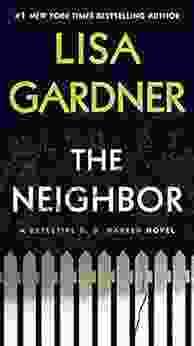
 Gary Cox
Gary CoxDetective Warren: A Gripping Tale of Suspense and...
Step into the enigmatic world of Detective...
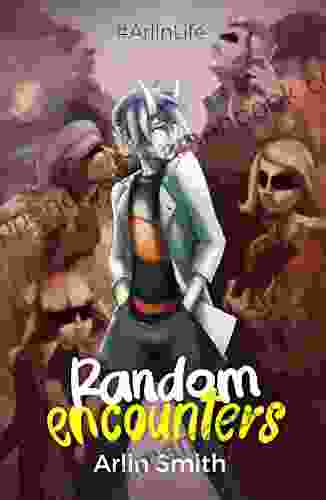
 Junot Díaz
Junot DíazArlinlife Random Encounters: An In-Depth Exploration of...
Arlinlife Random Encounters is a...
4.7 out of 5
| Language | : | English |
| File size | : | 20779 KB |
| Screen Reader | : | Supported |
| Print length | : | 213 pages |
| Lending | : | Enabled |
| Paperback | : | 96 pages |
| Item Weight | : | 6.4 ounces |
| Dimensions | : | 5.25 x 0.75 x 8.25 inches |


